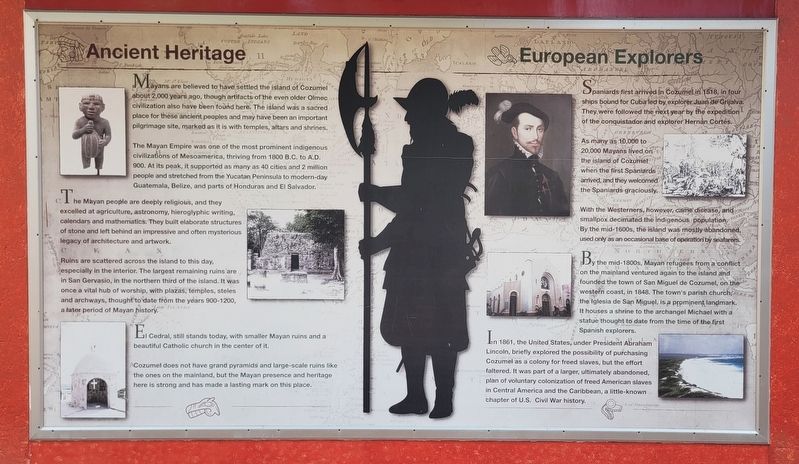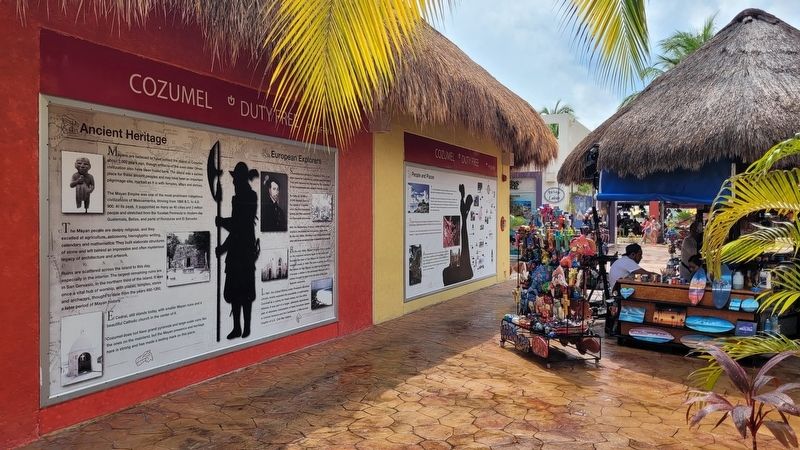San Miguel de Cozumel in Cozumel, Quintana Roo, Mexico — The Yucatan Peninsula (The Southeast)
Ancient Heritage
The Mayan Empire was one of the most prominent indigenous civilizations of Mesoamerica, thriving from 1800 B.C. to A.D. 900. At its peak, it supported as many as 40 cities and 2 million people and stretched from the Yucatan Peninsula to modern-day Guatemala, Belize, and parts of Honduras and El Salvador.
The Mayan people are deeply religious, and they excelled at agriculture, astronomy, hieroglyphic writing, calendars and mathematics. They built elaborate structures of stone and left behind an impressive and often mysterious legacy of architecture and artwork.
Ruins are scattered across the island to this day, especially in the interior. The largest remaining ruins are in San Gervasio, in the northern third of the island. It was once a vital hub of worship, with plazas, temples, steles and archways, thought to date from the years 900-1200, a later period of Mayan history.
El Cedral, still stands today, with smaller Mayan ruins and a beautiful Catholic church in the center of it.
Cozumel does not have grand pyramids and large-scale ruins like the ones on the mainland, but the Mayan presence and heritage here is strong and has made a lasting mark on this place.
European Explorers
Spaniards first arrived in Cozumel in 1518, in four ships bound for Cuba led by explorer Juan de Grijalva. They were followed the next year by the expedition of the conquistador and explorer Hernán Cortés.
As many as 10,000 to 20,000 Mayans lived on the island of Cozumel when the first Spaniards arrived, and they welcomed the Spaniards graciously.
With the Westerners, however, came disease, and smallpox decimated the indigenous population. By the mid-1600s, the island was mostly abandoned, used only as an occasional base of operation by seafarers.
By the mid-1800s, Mayan refugees from a conflict on the mainland ventured again to the island and founded the town of San Miguel de Cozumel, on the western coast, in 1848. The town's parish church, the Iglesia de San Miguel, is a prominent landmark. It houses a shrine to the archangel Michael with a statue thought to date from the time of the first Spanish explorers.
In 1861, the United States, under President Abraham Lincoln, briefly explored the possibility of purchasing Cozumel as a colony for freed slaves, but the effort faltered. It was part of a larger, ultimately abandoned,
plan of voluntary colonization of freed American slaves in Central America and the Caribbean, a little-known chapter of U.S. Civil War history.
Topics. This historical marker is listed in these topic lists: Churches & Religion • Exploration • Native Americans • War, US Civil. A significant historical year for this entry is 1800 BCE.
Location. 20° 28.531′ N, 86° 58.497′ W. Marker is in San Miguel de Cozumel, Quintana Roo, in Cozumel. Marker can be reached from Quintana Roo C-1, 0.1 kilometers south of Av. Claudio Canto. The marker is located in southern section of the Puerto Maya Cruise Ship Maritime Terminal. Touch for map. Marker is in this post office area: San Miguel de Cozumel QR 77675, Mexico. Touch for directions.
Other nearby markers. At least 8 other markers are within walking distance of this marker. Diosa Ixchel / Goddess Ixchel (a few steps from this marker); Coral Reefs (within shouting distance of this marker); Chac mool (within shouting distance of this marker); Calendario maya / Mayan calendar (within shouting distance of this marker); Los Sacerdotes Mayas / The Mayan Priests (within shouting distance of this marker); Land of Chocolate (within shouting distance of this marker); Chac-Mool (within shouting distance of this marker); Tzolkin (approx. 0.3 kilometers away). Touch for a list and map of all markers in San Miguel de Cozumel.
Also see . . . Maya civilization. Wikipedia (Submitted on September 21, 2023, by James Hulse of Medina, Texas.)
Credits. This page was last revised on September 21, 2023. It was originally submitted on September 20, 2023, by James Hulse of Medina, Texas. This page has been viewed 54 times since then and 17 times this year. Photos: 1, 2. submitted on September 21, 2023, by James Hulse of Medina, Texas.

